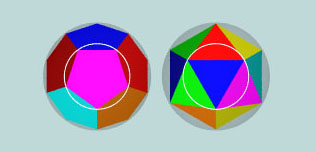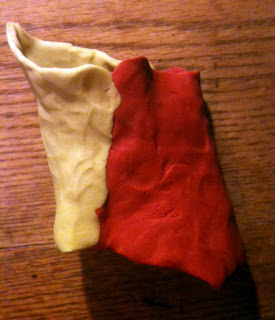Every fall there is a night which comes with cruel cold and kills flowers in my garden. It happened Friday night. It was clear and still with stars looking particularly bright through the skylight above my bed. I could not sleep so I reached for my iPad to catch up on Twitter I neglected yesterday.
Evelyne Lamb's tweet pointed out on some strange label in Science post. This post is interesting because it eatures interesting competition - Dance your PhD. There are videos of finalists of this competition, and of course, as a mathematician you would look up is there any about mathematics. Yes, there is one - Cutting sequences on Veech surfaces - except it is labeled as ...physics!:
<iframe src="http://player.vimeo.com/video/47049144" width="400" height="300" frameborder="0" webkitAllowFullScreen mozallowfullscreen allowFullScreen></iframe>
May be this whole thing is somehow connected to physics in actual PhD thesis but I could not find any reference, except this on Wikipedia which says that Diana Davis is a fictional character with PhD in physics. However the real Diana Davis is a mathematician whose research interests about Veech surfaces arose from her interest in symbolic dynamics.
I never heard about Veech surfaces before and I do not know what symbolic dynamics is about. So I do search and come to Wikipedia definition of Veech surface. If you are as ignorant in this area as I am - clicking on provided link won't help. The next step logically is to read An Introduction to Veech surfaces by Pascal Hubert and Thomas Schmidt. They promise "a gentle introduction to the basics of Veech surfaces" . I start reading until I get to this place:
The 1-form dz on the complex plane induces a 1-form on our surface.It is 2:30 am, and I can understand each word separately but cannot put all this together. I am relieved that next follows an example of unfolding.
There is a unique complex structure on the surface such that this 1-form is holomorphic. The process thus results in a Riemann surface with a distinguished abelian differential (that is, holomorphic 1-form). There is a close relationship between the flows on the flat surface and various properties of the 1-form.
The first one is easy to understand because it is about flat torus. Animation how to transform rectangle into flat torus is here. Jeff Weeks has developed Torus games.
Torus has even inspired piano piece:
<iframe width="560" height="315" src="http://www.youtube.com/embed/x7URBLhJs7Y" frameborder="0" allowfullscreen></iframe>
By now it is 3 am, and I am still thinking of Veech surface. That dance gives a very nice illustration how this surface can be otained by identifying sides but I cannot visualize. I am trying to get back to sleep but I am still puzzled with what I read in Hubert's and Schmidt's paper: " An easy Euler characteristics calculation shows that it has a genus two. As a genus two surface it has a hyperbolic covering."
I crocheted genus two surface - those are "hyperbolic pair of pants" - identifying every other side of the octagon on a hyperbolic plane with interior angle 45 degrees we will end up with a two hole torus.
 |
| Hyperbolic octagon with 45 degree angles and velcro strips on the sides that will be identifyed (glued together) |
Hyperbolic pair of pants were mentioned in very good Erica Klareich's paper Getting into Shapes: from Hyperbolic Geometry to Cube Complexes and back celebrating 30 years since Bill Thurston's original paper.
3:30 am - Veech surface can be covered with hyperbolic plane? I know what the hyperbolic plane is but how could I possibly make this Veech surface out of it? If flat torus "opens up" in a square, will Veech surface can be "opened" in rectangular pentagon on a hyperbolic plane?
 |
| it is impossible to have a square grid on a hyperbolic plane but we can have rectangular pentagonal grid, also hexagonal, heptagonal and so forth |
In the morning I draw two joined pentagons and color their sides the same way I saw in the movie.
Next step is to glue together (identify) two sides with the same color. The black strip in the middle is already two sides joined, so I join green ones.
But now I cannot get any further in three dimensional world we live in - I need another dimension. While I am pondering on how to get over this obstacle my husband passes by and asks what am I trying to create. I tell him that I want to see how Veech surface can have a hyperbolic plane as a covering. David looks at me and says - you are trying to think about it as geometric manifold but it is not - this is topology. Hyperbolic plane is its covering in the same sense as a sphere is a covering of the cube. That is something I grasp easy - imagine your cube (tetrahedron, dodacahedron, etc.) made from a rubber, then you can blow it up like a baloon and it will result in a sphere.
For Veech surface it should be opposite to the sphere - instead of "blow up" it should rather be called "suck in". I sigh and think that I should have woken David up at night to resolve this.Still I do not have an image how Veech surface would look. If it is topologically like a two hole torus then I should be able to make it using play-dough.
This far I got with my paper model. Now I should stretch it and should be able to join more sides.
Well this is one step further. It reminds me of something....
Here it is! My play-dough sculpture looks like a hyperbolic plane I crocheted years ago and then folded. My wish to see how Veech surface could be connected to the hyperbolic plane is satisfied, and I go outside to assess a damage the freeze has done to the garden.
Mums have survived, so I will have flowers for a while.
In the afternoon I pass by David's study and notice a lot of post-its on his desk.
Now it is my turn to ask - what are you doing? He smiles - you infected me. Get that play dough.
So we continue together until we do find the way how these four holes can be connected to get a two hole torus. I must say - nothing elegant but at least I can get away to cook a dinner.
I wrote in my book about some uses and connections of the hyperbolic plane. I am still very interested to find more, so mention of the hyperbolic plane in connection with Veech surface caught my interest and I wanted to understand what is this connection. I am happy to find that the hyperbolic plane is getting more and more popular. The latest use of it in popular culture was this nice cartoon strip by Bill Amend from http://www.foxtrot.com/
I am going now to make hyperbolic pancakes - may be that will be easier than crochet...
Greetings from Ithaca where after Friday night's freeze today was almost summer...














Someone pointed me to this post -- I'm quite honored that pondering the implications of my video kept you up until the early hours of the morning!
ReplyDeleteFor visualizing how the double pentagon glues up into a genus-two surface, the best diagram I've seen is on page 5 of Hatcher's Toplogy:
He does it for the regular octagon, but as you can see in the colored pentagon you made, if you ignore the black edges that are glued together, the double pentagon is a non-regular octagon with parallel edges identified.
As for what a Veech surface is, I was confused about it until Ronen Mukamel explained it to me. Basically, consider the square torus (a square, with parallel edges identified). This surface has two obvious symmetries: rotation by multiples of 90°, and reflection across vertical, horizontal or diagonal lines.
But there is another symmetry: you can shear the square into a parallelogram, cut it up, and reassemble it back into a square. As it turns out, this preserves the edge identifications. I explain it, with pictures, in Section 2.3 of my double pentagon paper.
The magical thing is that lots of surfaces that you wouldn't expect have this same shearing property -- for example, the double pentagon. As shown in the video, you can shear it, and then cut it up and reassemble it back into a double pentagon, while preserving the edge identifications. That's what makes it a Veech surface.
I like that explanation better than talking about holomorphic 1-forms, though of course those are required for rigor.
Dear Diana - what a nice response to my pondering! Thank you! I have to admit it was not your dance that kept me awake - so do not feel responsible for that :-) But it was nice to find your excellent dance and from there to learn some new things. I never had proper topology course but my husband is topologist (well, retired now) and several semesters I attempeted to sit in Thurston's seminars. And now I know if the Veech surface will still bother me I should go and talk to my colleague Alan Hatcher! Good luck with your work and I will cross fingers for your dance to win!
ReplyDelete